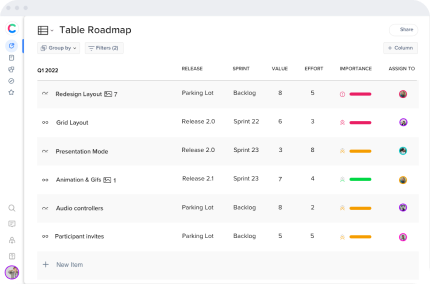What is smart goal setting?
SMART goal setting is a term used to describe how project managers develop goals that lead to more favorable outcomes. As its acronymic name suggests, it aids the design of clear, measurable, attainable, relevant, and time-bound goals for products and roadmaps. Each of these factors gives clarity, fuels motivation, and raises the likelihood of success. SMART goals can also be used by anybody, anywhere, with no specific equipment or training required.
What does SMART stand for?
You may have set objectives that felt impossible to reach. Working toward an unclear goal can quickly become frustrating and demotivating. The SMART goal framework helps turn that uncertainty into clarity, giving you a solid foundation for success.
To make sure your goals are focused and achievable, each one should be:
Specific – Define exactly what you want to achieve. Clearly define the who, what, and why behind every objective to create direction and purpose.
Measurable – Use clear metrics or KPIs to track progress and celebrate success along the way.
Achievable – Set realistic, attainable goals that align with your team’s resources and timelines.
Relevant – Ensure every goal supports your product vision, customer needs, and business strategy. Ensure the goal is realistic, given your resources and constraints.
Time-bound – Set clear deadlines to support effective time management, create accountability, and build momentum. Specify when the goal should be accomplished to maintain focus and urgency.
When you define a SMART objective, you need to tick off all the criteria included in the acronym. These are the essential factors that will eventually make or break the purposes of your project plan, product strategy, and development activities in general. Applying the SMART framework keeps your product roadmap focused, transparent, and aligned with both stakeholder expectations and customer value.
Benefits of using the SMART framework for goal setting
SMART is a robust tool that helps you achieve your objectives by providing clarity, focus, and drive. It can also urge you to achieve them by pushing you to establish your goals and set a deadline for completing them.
Without clear and realistic goals, a project can implode under its weight. Project managers may make the most out of their time and resources by implementing the SMART goal-setting approach. This is achievable because the framework gives clarity, concentration, and drive, driving teams to achieve complex goals quickly.
Overall, the benefits of employing the SMART goal-setting approach are closely tied to the higher percentage of positive outcomes in project management. After all, you can reach your target by understanding where you’re headed.
How to implement SMART goal setting
Implementing SMART goals starts with applying the SMART criteria to set goals that are clear, measurable, and aligned with your overall strategy. Begin by defining what success looks like and breaking larger ambitions into smaller, actionable steps that make progress easy to track and sustain.
Select meaningful metrics or KPIs to measure performance and review them regularly to stay on track. Encourage collaboration and communication so everyone understands their role in reaching the goal.
Smarter goal setting is a continuous process. As priorities evolve, revisit and adjust your goals to keep them relevant, achievable, helping your team stay aligned and focused on delivering measurable results.
SMART objectives explained: How to set SMART goals
Specific goals have a far better likelihood of being achieved. To make a plan more precise, examine the five “W” questions:
Who: Who is involved in achieving this goal?
What: What do I want to achieve?
Where: Where will this aim be attained?
When: When do I want to complete this task?
Why: What motivates me to pursue this goal?
To ensure you don’t miss anything, define your purpose by answering the five Ws: who, what, where, when, and why. For example, if you’re building a finance platform, a specific goal might be: “I want to organize a team of two UX designers and four developers to build a finance platform that becomes the top solution for small businesses by the third quarter of next year.”
Your SMART goal should build on the five Ws by adding clear ways to measure success, like tracking features delivered or tests completed. Make sure your goals are realistic, connected to your overall business goals, and supported by clear deadlines and smaller milestones to stay focused and move forward consistently.
Why the SMART goal method matters
Many product managers struggle to meet too broad goals or strive to hit too many targets without seeing meaningful results. By adopting a SMART goal planning approach, they can cut through the clutter and restrict their teams’ focus on clear, reachable targets.
While it’s an invaluable tool for product managers, the SMART approach is simple enough for anyone to use across any role, department, or area of life. It helps define clear boundaries, outline the steps to success, and identify the resources and milestones needed to measure real progress.
By using the SMART goal method, teams can align around achievable objectives, stay accountable, and move with purpose toward impactful results.
FAQ
What are the 5 rules for setting SMART goals?
The five components of a SMART goal are Specific, Measurable, Achievable, Relevant, and Time-bound. It should be clear, trackable, realistic, aligned with your objectives, and set within a defined timeframe.
What are 5 SMART goal examples?
Examples include increasing user retention by 15% in six months, launching three new features by Q3, growing active users by 20% next quarter, cutting support response time to two hours, and boosting conversions by 10% in three months.
Can SMART goals change over time?
Yes. SMART goals should be reviewed and adjusted as priorities shift, new data emerges, or constraints evolve


